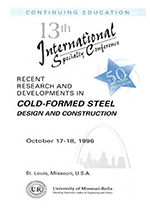Session Dates
17 Oct 1996
Abstract
The bending behaviour of cold-formed steel beams is far from simple. The double symmetry associated with hot-rolled I-sections is generally uneconomical and the use of thin-walled slender elements means that local buckling of parts of the cross-section in compression may be a significant design factor leading to additional asymmetry of behaviour. Furthermore, the modern tendency to introduce additional folds in order to control local buckling and to produce more favourable global section properties also serves to aggravate the tendency towards distortional buckling. Generalised Beam Theory (GBT) has wide application to the analysis and design of cold-formed beams and can provide a relatively simple approach to the problems associated with the alternative buckling modes in thin-walled beams and their various interactions. Historically, both the local and global bucking of beams have been intensively researched and the appropriate design methods have been well documented. Recent research shows that distortional buckling may also be critical in beams of practical proportions and the relative lack of research and the weakness of design approaches dealing with distortional buckling in the available codes and standards is a deficiency in the design of cold-formed steel structures. With the aid of GBT, some recently proposed design approaches are evaluated and improvements are proposed. Further investigation shows that the Perry-Robertson equation can be used to introduce a yield criterion in order to empirically modify the elastic distortional buckling moment and thus to predict the buckling strength of a member.
Department(s)
Civil, Architectural and Environmental Engineering
Research Center/Lab(s)
Wei-Wen Yu Center for Cold-Formed Steel Structures
Meeting Name
13th International Specialty Conference on Cold-Formed Steel Structures
Publisher
University of Missouri--Rolla
Document Version
Final Version
Rights
© 1996 University of Missouri--Rolla, All rights reserved.
Document Type
Article - Conference proceedings
File Type
text
Language
English
Recommended Citation
Jiang, C. and Davies, J. Michael, "Design of Thin-walled Beams for Distortional Buckling" (1996). CCFSS Proceedings of International Specialty Conference on Cold-Formed Steel Structures (1971 - 2018). 3.
https://scholarsmine.mst.edu/isccss/13iccfss/13iccfss-session2/3
Design of Thin-walled Beams for Distortional Buckling
The bending behaviour of cold-formed steel beams is far from simple. The double symmetry associated with hot-rolled I-sections is generally uneconomical and the use of thin-walled slender elements means that local buckling of parts of the cross-section in compression may be a significant design factor leading to additional asymmetry of behaviour. Furthermore, the modern tendency to introduce additional folds in order to control local buckling and to produce more favourable global section properties also serves to aggravate the tendency towards distortional buckling. Generalised Beam Theory (GBT) has wide application to the analysis and design of cold-formed beams and can provide a relatively simple approach to the problems associated with the alternative buckling modes in thin-walled beams and their various interactions. Historically, both the local and global bucking of beams have been intensively researched and the appropriate design methods have been well documented. Recent research shows that distortional buckling may also be critical in beams of practical proportions and the relative lack of research and the weakness of design approaches dealing with distortional buckling in the available codes and standards is a deficiency in the design of cold-formed steel structures. With the aid of GBT, some recently proposed design approaches are evaluated and improvements are proposed. Further investigation shows that the Perry-Robertson equation can be used to introduce a yield criterion in order to empirically modify the elastic distortional buckling moment and thus to predict the buckling strength of a member.



